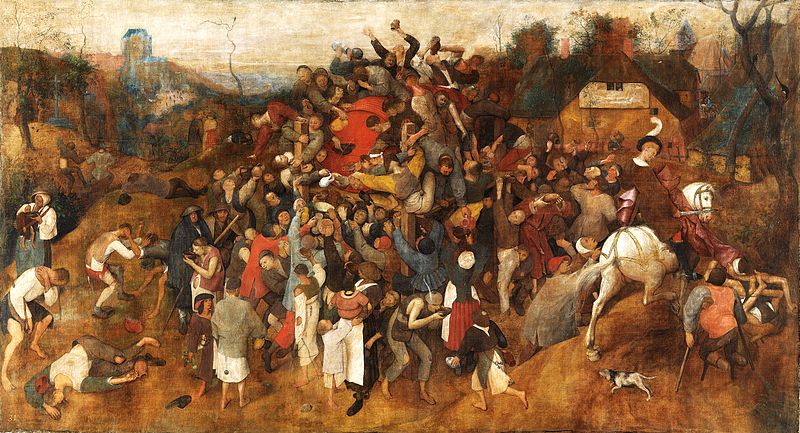
The Wine of Saint Martin's Day , Pieter Bruegel the Elder
c. 1565–1568
Glue-size tempera on linen
148 cm × 270.5 cm (4 ft 10 in × 8 ft 10 in)
Museo del Prado, Madrid
----
. Πήτερ Μπρίγκελ ο πρεσβύτερος
---
The Wine of Saint Martin's Day is the largest painting by Pieter Bruegel the Elder. It is currently held in the Museo del Prado, Madrid, where it was identified as a Breugel original in 2010. Like much of Bruegel's work it depicts peasant life, in this case a festival known as St. Martin's Day, which involves drinking the first wine of the season.
Description of painting
The picture depicts a popular festival celebrated on 11 November. Although it is not a religious painting as such, it contains references to Christianity. There is a roadside cross, which the peasants seemingly ignore, and among the many figures is a group which alludes to the legend of St Martin of Tours dividing his cloak to share it with a beggar. This idea of having an important theme relegated to the side of the painting is paralleled in, for example, Landscape with the Fall of Icarus, which also highlights ordinary events.
The picture has been dated on stylistic grounds to the 1560s. It is one of four surviving works by this artist executed in glue-size on linen (Tüchlein). By the early twenty-first century, when its owners took it to the Prado for restoration, the painting was not in a good state of conservation .[1] However, this is not surprising as the fragile medium tends to cause conservation problems. (On the other hand, The Blind Leading the Blind, one of the other three, is in relatively good condition).
Provenance
The work was identified as a Bruegel in 2010 at the Museo del Prado in Madrid. A study of the surface using X-rays revealed fragments of Bruegel's signature, thereby confirming his authorship. It was subsequently acquired by the Prado for less than its value on the open market.[2]
The Wine of Saint Martin's Day matches the description of a painting which was inventoried in the collection of the Gonzaga dukes of Mantua in the early seventeenth century. However, there is some doubt as to whether the painting in Mantua was the painting now in the Prado. It might, for example, have been a related painting now in Vienna's Kunsthistorisches Museum, which shows the group around St Martin.[3] The earliest documentary evidence which definitely relates to the work now in the Prado Museum is an inventory of the collection of a Spanish aristocrat, Luis Francisco de la Cerda, the ninth duke of Medinaceli. The inventory was drawn up after the duke's death in the early eighteenth century: he is assumed to have acquired the painting in Italy around the end of the seventeenth century.[4]
References
Vogel, Carol (24 September 2010). "In Rare Find, Prado Says Painting Is by Bruegel the Elder". New York Times. Retrieved 14 October 2010. This source describes the painting as a canvas, but the fabric is a finer one than this word implies.
(Spanish) García, Angeles (23 September 2010), Cultura inicia la adquisición por siete millones de una de las obras más importantes de Bruegel 'El Viejo', El País
Believed to be a copy by another member of the Bruegel family, the Vienna painting replicates the Saint Martin scene. ("Fest". Retrieved June 09, 2012. )
The painting’s provenance (Gonzaga (?), Medinaceli), Prado website (www.museodelprado.es)
External links
BBC news story
Close-up view, New York Times
----
Fine Art Prints | Greeting Cards | Phone Cases | Lifestyle | Face Masks | Men's , Women' Apparel | Home Decor | jigsaw puzzles | Notebooks | Tapestries | ...
----
Retrieved from "http://en.wikipedia.org/"
All text is available under the terms of the GNU Free Documentation License


